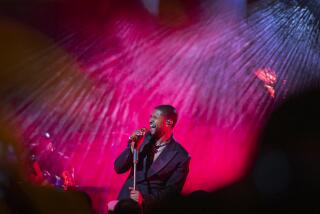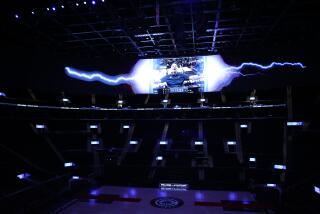Tupac hologram at Coachella 2012: What, that old thing?
The late Tupac Shakur rose again last weekend at Coachella -- brought to life by James Cameron’s visual production house Digital Domain, and two hologram-imaging companies, AV Concepts and the U.K.-based Musion Systems.
The capacity crowd reportedly went silent with shock when Shakur appeared to rise from the stage, shout a profanity filled version of “What’s up Coachella?” and then joined headliners Snoop Dog and Dr. Dre for two songs.
But that shock value will only last so long as holographic images are poised to increasingly feature in mainstream music performances.
We’ve seen a similar technique employed at the 2006 Grammys when a holographic Madonna took to the stage with the animated holographic band, the Gorrillaz.
And then there is the blue-haired Japanese pop star Hatsune Miku, an animated creation whose 3-D likeness has been performing to live audiences since 2010.
Will.i.am even showed up in holographic form for an interview on election night of 2008.
As for the idea of performing alongside a deceased person, well, Natalie Cole was doing performances of “Unforgettable” with a video of her dad projected on a screen behind her back in the early ‘90s.
But we’re about to see a whole lot more of this type of thing.
The Wall Street Journal reports that Dr. Dre is planning to take holographic Tupac on tour in the coming months.
“This is just the beginning,” Ed Ulbrich, chief creative officer at Digital Domain told the newspaper. “Dre has a massive vision for this.”
For now, Dr. Dre is remaining quiet on his future plans for the virtual Tupac, and he’s also asked Digital Domain and AV Concepts to refrain from telling the press too much about how they rendered the musician.
“He doesn’t want the magic spoiled for the people who will see it next weekend,” a spokeswoman for Digital Domain told the Los Angeles Times.
Still, those familiar with special effects say the holographic Tupac Shakur was created using the same concept as an old magic trick discovered in the 19th century known as Pepper’s Ghost.
The trick is to have a transparent piece of material that will still reflect an image that is projected onto it, while still allowing other people on the stage to move behind the image and in front of it.
In the olden days, the transparent material was usually glass. On Sunday’s performance it was Mylar, a highly reflective, lightweight plastic, stretched on a clear 30-by-13-foot screen customized by AV Concepts to descend onto the stage in seconds between sets of the performance.
If that makes the creation of a holographic Shakur seem easy, it’s not -- especially because the virtual Shakur’s performance was not based on archival footage.
“This is not him performing at some point, this is completely original, exclusive performance only for Coachella and that audience,” Ed Ulbrich, chief creative officer at Digital Domain told Bloomberg.
And because Shakur was a real person with a devoted fan following, it was crucial to get all his mannerisms, the tone of his voice, the placement of his tattoos, etc., correct.
The company created the virtual Tupac from video footage and photos of the rapper, working on the project for about four months.
That is its own kind of magic.
ALSO:
What’s Nintendo doing at the Louvre?
Siri helps Samuel Jackson hook up date night
Read It Later app becomes new pocket for online stuff
More to Read
Inside the business of entertainment
The Wide Shot brings you news, analysis and insights on everything from streaming wars to production — and what it all means for the future.
You may occasionally receive promotional content from the Los Angeles Times.











